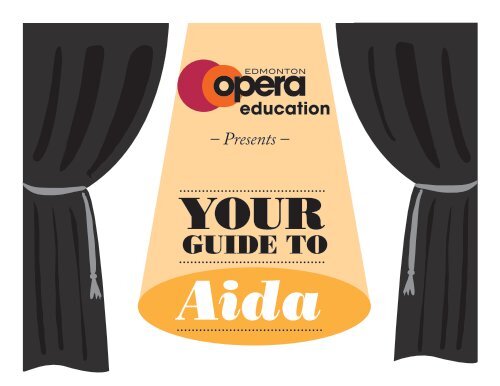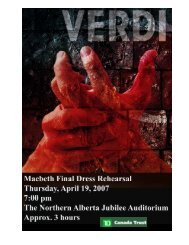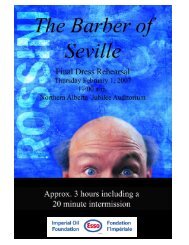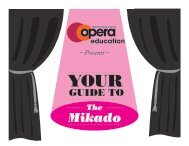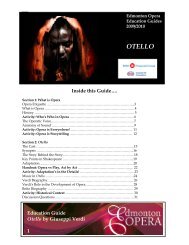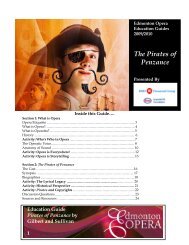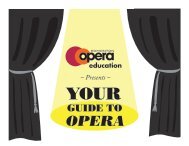Create successful ePaper yourself
Turn your PDF publications into a flip-book with our unique Google optimized e-Paper software.
education<br />
– Presents –<br />
YOUR<br />
GUIDE TO<br />
<strong>Aida</strong>
Overture<br />
As CEO of <strong>Edmonton</strong> <strong>Opera</strong> I want to thank you for participating in this,<br />
our first opera education program.<br />
I believe music – especially opera, can add a great richness to life.<br />
My first exposure to music came as a little girl sitting under <strong>the</strong> piano listening to my<br />
grandmo<strong>the</strong>r play and sing operatic arias. I remember loving music and taking piano<br />
lessons. I guess I persisted with those scales long enough because I have from time<br />
to time throughout my life taught piano and of course that served as good grounding<br />
for what was to become a career.<br />
As for opera, it was love at first sight and sound. As a young person in former<br />
Yugoslavia, a student could attend opera for <strong>the</strong> equivalent of 25 cents. For me it was<br />
all magic, as I was instantly taken by this rich art form that actually brings toge<strong>the</strong>r<br />
several o<strong>the</strong>r wonderful art forms such as… music, voice, sets, costumes, drama, love<br />
stories, lavish productions.<br />
Now you too will have a similar educational and experiential journey by being part<br />
of <strong>Edmonton</strong> <strong>Opera</strong>’s education program and Your Guide to <strong>Opera</strong>. We have created<br />
a thorough curriculum, practical and engaging teaching aids and yes, <strong>the</strong> opportunity<br />
for all to attend <strong>the</strong> dress rehearsal of an <strong>Edmonton</strong> <strong>Opera</strong> performance.<br />
This leads me naturally enough to tell you a bit about your hometown<br />
opera company.<br />
2<br />
First, I want to say what a great opera city we have here. We are a professional<br />
opera company backed by some of <strong>the</strong> greatest volunteers and corporate and civic<br />
leaders I have ever seen. I can’t tell you how fulfilling it is to be working with people,<br />
both staff and volunteers, who love opera and are willing to support it. <strong>Edmonton</strong><br />
<strong>Opera</strong> is <strong>the</strong> oldest and largest professional, year-round opera company in <strong>the</strong> Prairie<br />
Provinces, one of 17 opera companies in Canada and <strong>the</strong> fourth largest in terms<br />
of budget and artistic output. It is also one of five flagship arts organizations in<br />
<strong>Edmonton</strong>.<br />
Your <strong>Edmonton</strong> <strong>Opera</strong> will be celebrating a 50 th birthday soon and that is a real<br />
statement about <strong>the</strong> kind of long term support <strong>Edmonton</strong> and area has for us and<br />
as well for many of <strong>the</strong> o<strong>the</strong>r arts and cultural organizations in this great city.<br />
So welcome to <strong>the</strong> wonderful world of opera. Enjoy and learn.<br />
Sandra Gajic<br />
CEO | <strong>Edmonton</strong> <strong>Opera</strong>
<strong>Opera</strong> Live!<br />
Nothing beats <strong>the</strong> excitement of live opera!<br />
For more information on how your class can attend<br />
a dress rehearsal at special student pricing, contact<br />
usby email at education@edmontonopera.com<br />
or visit us online at:<br />
www.edmontonopera.com<br />
3<br />
Contents<br />
Message from Director | 4<br />
Characters | 5<br />
Synopsis | 6–7<br />
The Story Behind <strong>the</strong> Story | 8<br />
Europe at <strong>the</strong> Time of <strong>Aida</strong> | 9<br />
Piecing Toge<strong>the</strong>r an Ancient World | 10<br />
Kings, Pharaohs and Queens of Egypt | 11<br />
Composer Biography | 10<br />
Librettist & Story Creator Biographies | 11<br />
Glossary | 12<br />
Activity 1: Listening Guide | 14<br />
Activity 2: Nationalism & Identity | 21<br />
Activity 3: Improv Reader's Theatre |21<br />
Activity 4: Poster Creation | 22<br />
Activity 5: Facebook Character Development | 23<br />
Activity 6: <strong>Opera</strong> Notes | 23<br />
A special thanks to volunteer editor, Stephan Bonfield –<br />
writer of <strong>the</strong> <strong>Aida</strong> Synopsis and Listening Guide.<br />
New to opera?<br />
Be sure to check out our Educator's Guide, Your Guide to <strong>Opera</strong>, available for<br />
free download online. It is designed to supplement this guide and offers an<br />
overview of <strong>the</strong> history of opera, activities for your class, and useful information<br />
about attending our dress rehearsals.
Message from<br />
<strong>the</strong> Director:<br />
Dejan Miladinovic<br />
The curious eyes of <strong>the</strong> 14-year-old boy followed <strong>the</strong> flickering torch carried by<br />
<strong>the</strong> Arab guide. The corridor was narrow and steep. Even with <strong>the</strong> torch, guide<br />
and visitors felt as if <strong>the</strong>y were engulfed by thousand-year-old darkness. The boy<br />
couldn’t believe that he was walking in <strong>the</strong> footsteps of pyramid robbers.<br />
In <strong>the</strong> main hall of <strong>the</strong> Cairo Museum <strong>the</strong> boy watched <strong>the</strong> colossal statues<br />
with curiosity. He hesitated for only a moment with slight fear touching his<br />
face at <strong>the</strong> entrance into <strong>the</strong> Mummy Room. At <strong>the</strong> exit door <strong>the</strong> boy stopped<br />
in front of <strong>the</strong> bust of Queen Nefertiti. Motionless, he stared in amazement at<br />
such incomparable beauty.<br />
The boy had a precious chance to visit <strong>the</strong> museum every day, week by week,<br />
thanks to his fa<strong>the</strong>r’s all-season engagement as a conductor with <strong>the</strong> newly founded<br />
Cairo Symphony Orchestra. As a conductor, <strong>the</strong> fa<strong>the</strong>r insisted that concert programs<br />
promote serious symphonic music composed by Arabs and Copts, such as Rahim,<br />
Khairat, El-Shawan or Greiss. So, <strong>the</strong> bro<strong>the</strong>r of <strong>the</strong> late Egyptian composer Greiss,<br />
a doctor in Egyptology, became <strong>the</strong> boy’s one-month teacher, telling him stories<br />
about ancient Egypt, its people, its customs, its Pharaohs, and its gods and deities.<br />
The curious boy was an attentive listener and a quick learner.<br />
One day, all three of <strong>the</strong>m – <strong>the</strong> fa<strong>the</strong>r, <strong>the</strong> Egyptologist and <strong>the</strong> curious boy –<br />
went to <strong>the</strong> Sahara Desert to visit a newly discovered tomb, a mastaba ("house for<br />
eternity") of a rich ancient Egyptian merchant. For <strong>the</strong> first time in his life <strong>the</strong> boy<br />
stepped on <strong>the</strong> Sahara sands. It was an unforgettable feeling. The Egyptologist told<br />
4<br />
<strong>the</strong> boy: “Grab a handful of sand from <strong>the</strong> spot where you left your footprint<br />
and take it with you. This sand will always be a link with what you have<br />
experienced and learned about ancient Egypt.”<br />
The Egyptologist was right. The boy was enchanted forever.<br />
When I staged <strong>Aida</strong> for <strong>the</strong> first time, memories of that teenage boy were awakened.<br />
Although I have since enriched my knowledge about <strong>the</strong> grand mystical culture of<br />
ancient Egypt, I have remembered in great detail all Dr. Greiss' stories. There is <strong>the</strong><br />
story about <strong>the</strong> final epic battle between <strong>the</strong> gods Horus and Seth, a metaphor for<br />
<strong>the</strong> everlasting battle between good and evil. There is <strong>the</strong> fascinating battle between<br />
<strong>the</strong> sun god Atum Ra and <strong>the</strong> monstrous snake Apophis (deification of darkness and<br />
chaos) in <strong>the</strong> underworld, which acts as a metaphor for <strong>the</strong> ending of one day and <strong>the</strong><br />
beginning of <strong>the</strong> next. I’ve heard <strong>the</strong> stories about <strong>the</strong> goddess Bastet with <strong>the</strong> head of<br />
a cat, known as “<strong>the</strong> devouring lady,” <strong>the</strong> lion-headed goddess of war Sekhmet and <strong>the</strong><br />
goddess Hathor, of feminine love, who has horns on her head. Above all, of course,<br />
<strong>the</strong>re’s <strong>the</strong> story about Ptah, creator of <strong>the</strong> universe.<br />
The last words in <strong>the</strong> opera – “Immenso Ptah...” – were <strong>the</strong> initial start for my<br />
directorial thoughts about staging Verdi’s <strong>Aida</strong>. Fur<strong>the</strong>rmore, <strong>the</strong> battle between<br />
Atum Ra and Apophis is an excellent visual expression for <strong>the</strong> scene in which<br />
<strong>the</strong> sword is consecrated. The victory of Horus over Seth is <strong>the</strong> perfect triumphal<br />
representation of victory over Amonasro’s army. Thus, combining creative <strong>the</strong>atrical<br />
presentation with portions of <strong>the</strong> original spectacular rituals, along with emotionally<br />
strong personal scenes, is <strong>the</strong> proper way for reviving <strong>the</strong> spirit (Kha) of ancient<br />
Egypt. It seems to me <strong>the</strong> parts of my boyhood memories and <strong>the</strong> corresponding parts<br />
of Verdi's music are choosing each o<strong>the</strong>r by <strong>the</strong>mselves.<br />
In my directorial approach, I want to convey all my long-time intact excitements and<br />
emotions to <strong>the</strong> spectators, so <strong>the</strong>y could feel all <strong>the</strong> same as what <strong>the</strong> boy felt when he<br />
encountered <strong>the</strong> mummified time and space of <strong>the</strong> Pharaohs.<br />
Dejan Miladinovic<br />
August 2012
<strong>Aida</strong><br />
Education Dress Rehearsal<br />
Oct. 17 @ 11 am<br />
Jubilee Auditorium<br />
<strong>Aida</strong> <strong>Opera</strong> 101<br />
Oct. 10 @ 7 pm<br />
Art Gallery of Alberta<br />
Ledcor Theatre<br />
Join us for a thought provoking discussion surrounding<br />
<strong>Aida</strong>. With special guests from <strong>the</strong> fields of music,<br />
history, political science, and classics.<br />
Admission is complimentary, but please<br />
RSVP at education@edmontonopera.com<br />
5<br />
Characters<br />
<strong>Aida</strong> – an Ethiopian Princess (soprano)<br />
Radamès – Captain of <strong>the</strong> Egyptian Guard (tenor)<br />
Amneris – Daughter of <strong>the</strong> King of Egypt (mezzo-soprano)<br />
Amonasro – King of Ethiopia, fa<strong>the</strong>r of <strong>Aida</strong> (baritone)<br />
Ramfis – High Priest of Egypt (bass)<br />
Pharaoh – King of Egypt (bass)<br />
The Priestess (soprano)<br />
Messenger (tenor)
Synopsis<br />
Written by Stephan Bonfield<br />
ACT I<br />
Egypt is again threatened by Ethiopia. An Egyptian officer, Radamès, is c hosen to<br />
command <strong>the</strong> attack force against <strong>the</strong> Ethiopians. Left alone on stage, Radamès sings<br />
of his love for <strong>Aida</strong>, <strong>the</strong> Ethiopian slave of Amneris, <strong>the</strong> Egyptian princess. Radamès<br />
dreams of triumph in battle and being granted a victory prize by Pharaoh – having his<br />
beloved <strong>Aida</strong> freed.<br />
Amneris enters, and it is soon clear that she loves and admires Radamès. However,<br />
when <strong>Aida</strong> follows Amneris shortly after, Amneris observes Radamès trying to conceal<br />
his glances toward <strong>Aida</strong>. In <strong>the</strong> trio that follows, Radamès worries that Amneris may<br />
have discovered his love for <strong>Aida</strong> – a valid concern.<br />
Pharaoh arrives and a messenger delivers news of Ethiopia’s invasion. With Thebes<br />
now under threat, Pharaoh and <strong>the</strong> ga<strong>the</strong>red assembly cry out for war. Radamès<br />
will lead <strong>the</strong>ir troops into battle and Amneris is elated. Radamès thanks <strong>the</strong> gods,<br />
confident of victory. He is led to <strong>the</strong> temple of Vulcan to be anointed. The powerful<br />
scene continues with <strong>the</strong> chorus of priests and citizens invoking <strong>the</strong>ir gods to bring<br />
victory to Egypt and death to <strong>the</strong> Ethiopians. Amneris presents Radamès with a<br />
staff that is blessed to ensure his victory.<br />
<strong>Aida</strong>, now alone, is filled with self-reproach for repeating <strong>the</strong> impious words calling<br />
for Egyptian victory. She is torn between her love for Radamès and her loyalty to<br />
Ethiopia. If <strong>the</strong> Egyptians are defeated and her fa<strong>the</strong>r rescues her from slavery,<br />
Radamès may die. If Radamès is victorious, her fa<strong>the</strong>r may be enslaved or killed<br />
and her country destroyed.<br />
6<br />
At <strong>the</strong> temple, priests chant hymns to <strong>the</strong>ir gods. Radamès receives <strong>the</strong><br />
consecrated armour and sword and now acts with <strong>the</strong> powers of <strong>the</strong> gods<br />
to protect and defend Egypt.<br />
ACT II<br />
Egypt is victorious against <strong>the</strong> Ethiopians. Amneris is prepared for<br />
<strong>the</strong> victory celebration by her attendants while she dreams of Radamès.<br />
<strong>Aida</strong> enters. Amneris is suspicious about her slave’s feelings, but does not yet<br />
know <strong>Aida</strong>’s true identity. At first, Amneris responds with genuine affection to<br />
<strong>Aida</strong>, but <strong>the</strong>n deliberately misleads her, telling her that Radamès died in battle.<br />
Hearing this, <strong>Aida</strong> cannot hide her despair. Amneris knows she has discovered <strong>the</strong><br />
truth. With complete guile, Amneris contradicts <strong>the</strong> news, telling her Radamès lives.<br />
<strong>Aida</strong> is elated, but having discovered her secret, Amneris declares herself <strong>Aida</strong>’s rival.<br />
The Grand March accompanies <strong>the</strong> entrance of Pharaoh and <strong>the</strong> court, and a ballet<br />
of celebration displays <strong>the</strong> treasures taken as <strong>the</strong> spoils of victory. During <strong>the</strong> Triumphal<br />
scene, Radamès is praised as Egypt’s saviour.<br />
As his reward, Radamès asks Pharaoh for mercy for <strong>the</strong> prisoners. One of <strong>the</strong> prisoners<br />
is Amonasro, King of Ethiopia and <strong>Aida</strong>’s fa<strong>the</strong>r, disguised as an officer. Recognizing<br />
him, <strong>Aida</strong> cries out “My fa<strong>the</strong>r!” When <strong>the</strong>y embrace, he tells her quietly not to reveal<br />
his true identity as king.<br />
But <strong>the</strong> high priest Ramfis and <strong>the</strong> priests are indignant to Radamès’ wish. They advise<br />
Pharaoh to sentence <strong>the</strong> prisoners to death for fear <strong>the</strong> captives will rise up and attack<br />
Egypt again. Radamès reminds Pharaoh of his promise to free <strong>the</strong> Ethiopians; he<br />
believes <strong>the</strong>ir king was killed in battle and <strong>the</strong> enemy has no hope of mounting ano<strong>the</strong>r<br />
attack. Ramfis suggests a compromise: free <strong>the</strong> prisoners, keeping <strong>Aida</strong> and Amonasro<br />
as hostages. Pharaoh agrees and announces <strong>the</strong> marriage of Radamès to Amneris.<br />
In <strong>the</strong> grandiose finale, Amneris gloats at her triumph, <strong>Aida</strong> despairs, Radamès is<br />
tornand confused, and Amonasro, thinking his daughter is despondent at <strong>the</strong> thought<br />
of never being free, urges her to be patient. He is still unaware of his daughter’s<br />
love for Radamès.
Synopsis: Con't<br />
ACT III<br />
Amneris and Ramfis arrive at <strong>the</strong> temple to pray amid hymns for wedding preparations.<br />
Homesick for Ethiopia, <strong>Aida</strong> appears for a secret meeting with Radamès. Meanwhile,<br />
Amonasro has learned his daughter loves Radamès. Amonasro warns his daughter<br />
that Amneris will destroy her. Invoking patriotism, Amonasro tells <strong>Aida</strong> that she is<br />
obligated to help <strong>the</strong> Ethiopians defeat <strong>the</strong> Egyptians, promising she can have her<br />
country, her throne and Radamès. Amonasro manipulates his daughter, convincing<br />
her to learn Radamès’ tactical military secrets. When <strong>Aida</strong> refuses, Amonasro calls<br />
her a traitor to her people, unless she relents and betrays Radamès. <strong>Aida</strong> agrees.<br />
Radamès appears. <strong>Aida</strong> denounces him as Amneris’ husband, but Radamès swears<br />
he only loves <strong>Aida</strong>. She argues that <strong>the</strong> only solution is to flee to Ethiopia, describing<br />
<strong>the</strong>ir blissful life toge<strong>the</strong>r. Radamès hesitates; <strong>Aida</strong> renounces him and tells him to go<br />
to Amneris. Radamès refuses, deciding to flee with <strong>Aida</strong>. He reveals that <strong>the</strong> road along<br />
<strong>the</strong> gorges of Napata will be safe until tomorrow, when <strong>the</strong> Egyptian armies attack<br />
<strong>the</strong> Ethiopians at dawn. Amonasro, in hiding, hears this and reappears, announcing<br />
he is both <strong>the</strong> presumed-dead king and <strong>Aida</strong>’s fa<strong>the</strong>r. Upset, Radamès realizes he has<br />
betrayed his country.<br />
Amneris and Ramfis exit <strong>the</strong> temple, overhearing Radamès’ betrayal. They accuse him<br />
of treachery. Radamès prevents Amonasro’s attempt on Amneris’ life, and Amonasro<br />
and <strong>Aida</strong> flee. Guards appear and arrest Radamès.<br />
7<br />
ACT IV<br />
With Ethiopia defeated, <strong>Aida</strong> fears Radamès will be considered a traitor, condemned<br />
to die by <strong>the</strong> priests. Amneris decides if Radamès renounces <strong>Aida</strong>, she will use her<br />
power to persuade Pharaoh to pardon Radamès. Radamès, however, has accepted his<br />
fate. He believes <strong>Aida</strong> is dead and does not care about his own life. Amneris reveals<br />
that <strong>Aida</strong> lives and pleads with him to save his life by living for her. When Radamès<br />
refuses Amneris, she lapses into anger and intense frustration, only underscoring her<br />
defeat more. Radamès, oblivious, is led off to trial.<br />
The priests intone <strong>the</strong> charges against Radamès, who enters no plea for his life.<br />
He is sentenced to be buried alive. Amneris remains outside, cursing <strong>the</strong> priests<br />
and crying to <strong>the</strong> gods.<br />
In <strong>the</strong> crypt, Radamès is joined by <strong>Aida</strong>, who has elected to die with him. Their duet<br />
affirms <strong>the</strong>y believe <strong>the</strong>y will be immortalized in heaven. Above <strong>the</strong> tomb, Amneris<br />
prays for Radamès: “Pace, t’imploro, pace t’imploro, pace, pace, pace!” (“I pray for peace,<br />
I pray for peace!”)
The Story Behind <strong>the</strong> Story<br />
While it is popular belief that <strong>Aida</strong> was commissioned by <strong>the</strong> Khedive of Egypt<br />
to celebrate <strong>the</strong> opening of <strong>the</strong> Suez Canal in 1869, Verdi had in fact declined <strong>the</strong><br />
Khedive’s offer. As part of <strong>the</strong>se opening celebrations, an opera house in Cairo was<br />
also underway to be opened <strong>the</strong> same year. The Khedive of Egypt was an admirer of<br />
all things European and desired to commission an opera to commemorate <strong>the</strong> two<br />
openings. While Verdi resisted writing a special piece for <strong>the</strong> occasion, <strong>the</strong> house<br />
still opened with one of Verdi’s existing popular operas - Rigoletto.<br />
When Verdi learned from Camille du Locle (a director and librettist of Don Carlos)<br />
that <strong>the</strong> Khedive had decided to offer <strong>the</strong> commission of a dedicatory opera to ano<strong>the</strong>r<br />
composer, he quickly changed his mind and undertook <strong>the</strong> challenge to write a unique<br />
opera for <strong>the</strong> Cairo house himself. Commissioned for <strong>the</strong> large sum of 150,000 francs,<br />
Verdi began composing in 1870. He wished to create a grand spectacle, akin to French<br />
grand opera, with scenes of splendour, a large orchestra and chorus.<br />
The Khedive had worked closely with French Egyptologist Auguste Mariette asked<br />
him to create a plot based on his historical research of ancient Egypt to be used for<br />
an opera. It was later reworked and expanded by Camille du Locle and presented as<br />
a synopsis to Verdi. The composer accepted <strong>the</strong> story and <strong>the</strong> libretto was written by<br />
Antonio Ghislanzoni. While <strong>the</strong> premiere was planned for January 1871, <strong>the</strong> outbreak<br />
of Franco-Prussian War in Europe left Auguste Mariette unable to leave Paris.<br />
Leaving him stranded with <strong>Aida</strong>’s costumes and sets, <strong>the</strong> premiere was forced to<br />
be delayed until December.<br />
When <strong>Aida</strong> premiered December 1871 at <strong>the</strong> Khedival <strong>Opera</strong> House, it was met<br />
with great acclaim. Verdi was not in attendance, and a year later in 1872 <strong>Aida</strong> made<br />
its European debut at <strong>the</strong> famous La Scala Theatre in Milan.<br />
8<br />
Following <strong>the</strong> opening of <strong>Aida</strong>, it quickly became popular throughout Italy and<br />
expanded worldwide opening in NYC in 1873, and in Paris and London in 1876.<br />
It remains one of <strong>the</strong> most performed operas today; ranking among <strong>the</strong> top 20<br />
most frequently performed operas throughout <strong>the</strong> world.
Europe at <strong>the</strong> Time of <strong>Aida</strong><br />
During <strong>the</strong> time <strong>Aida</strong> was written, Europe was facing great political change. In 1870<br />
France under Napoleon III declared war on <strong>the</strong> German Kingdom of Prussia, but was<br />
defeated and as a result lost <strong>the</strong> regions of Alsace and Lorraine. Prussia was aided by<br />
<strong>the</strong> o<strong>the</strong>r German states and <strong>the</strong> victory led to <strong>the</strong> unification of <strong>the</strong> German Empire<br />
under King William I of Prussia. In Italy, nationalists fought to unify <strong>the</strong> country –<br />
even Verdi and <strong>Aida</strong> librettist Antonio Ghislanzoni were involved in <strong>the</strong> political<br />
change culminating in <strong>the</strong> country.<br />
Verdi often reflected <strong>the</strong> political turbulence of <strong>the</strong> time in his operas and became<br />
known as <strong>the</strong> “Composer of <strong>the</strong> Revolution” after Nabucco premiered in 1842.<br />
This opera portrayed <strong>the</strong> Hebrew people oppressed by <strong>the</strong> tyranny of <strong>the</strong> Babylonians.<br />
This plot which resonated and even caused chaos with <strong>the</strong> Italian audiences of <strong>the</strong><br />
time was considered to be replete with political overtones, paralleling its story to<br />
<strong>the</strong> Austrian control over <strong>the</strong>ir country.<br />
<strong>Aida</strong> is no exception; in this opera Verdi continued to present <strong>the</strong>mes of political<br />
instability as shown through Radamès and <strong>Aida</strong> who must choose between <strong>the</strong>ir<br />
patriotic duties versus eternal happiness through love. In <strong>the</strong> face of love for one’s<br />
country and love for <strong>the</strong> enemy, a feasible solution seems impossible. Verdi creates<br />
dramatic tension throughout <strong>the</strong> opera by making his characters face <strong>the</strong>ir<br />
conflicting loyalties.<br />
9
Piecing Toge<strong>the</strong>r an Ancient World<br />
French Archeologist and Egyptologist Auguste Mariette was hired by <strong>the</strong> Khedive<br />
of Egypt to create a plot based on his historical findings for Verdi. With his expertise<br />
he was also involved in <strong>the</strong> design of <strong>the</strong> costumes and sets for its premiere in 1871.<br />
Mariette studied how ancient Egyptians lived from paintings to architecture,<br />
to create au<strong>the</strong>ntic scenery and costumes depicting <strong>the</strong>se ancient times.<br />
Frequently, productions of <strong>Aida</strong> today reference traditional ancient Egypt set during<br />
<strong>the</strong> Dynasty of <strong>the</strong> Pharaohs particularly in Memphis and Thebes. Visuals on set<br />
portray <strong>the</strong> grandiosity of Pharaohs, recognizable symbols such as <strong>the</strong> Pyramids<br />
of Giza, <strong>the</strong> Great Sphinx as well as ornate gold costumes.<br />
The history of ancient Egypt is divided into dynasties which mark <strong>the</strong> succession<br />
of Egyptian rulers. Knowledge of <strong>the</strong>se periods is based on kinglists recorded by<br />
Egyptians <strong>the</strong>mselves that have been preserved in carvings such as <strong>the</strong> famous<br />
Palermo Stone and Abydos Kinglist (carved on <strong>the</strong> temple), and writings on papyrus<br />
like <strong>the</strong> Turin Canon. An Egyptian historian and priest in <strong>the</strong> temple of Heliopolis<br />
named Manetho wrote History of Egypt (or Aegyptiaca) in <strong>the</strong> third century bc<br />
This work, in which he organized <strong>the</strong> kings into <strong>the</strong> thirty dynasties, is evidence<br />
of <strong>the</strong> reign of pharaohs. These records combine to provide archeologists with<br />
fragmented answers that help structure <strong>the</strong> history into <strong>the</strong> series of kingdoms<br />
and periods we know as ancient Egypt.<br />
Fur<strong>the</strong>r Learning<br />
• Visit Discovery Channel online dsc.discovery.com/egypt/ for video<br />
clips about ancient Egypt.<br />
• National Geographic.com also provides many great photos of ancient<br />
and modern day Egypt.<br />
10
Kings, Pharaohs and Queens of Egypt<br />
Ancient Egyptian kings were <strong>the</strong> leaders and preservers of peaceful and stable society.<br />
From performing religious rituals to seeing to economic needs, <strong>the</strong> king was deemed<br />
as protector of <strong>the</strong> country. It was believed that <strong>the</strong> god Horus was connected to living<br />
kings, while <strong>the</strong> god Osiris was associated with dead kings. Even though <strong>the</strong> kings were<br />
linked to <strong>the</strong> gods, ancient rituals show that <strong>the</strong> ancient Egyptians were aware of <strong>the</strong><br />
mortality of <strong>the</strong>ir kings.<br />
While kingship ideally passed on from fa<strong>the</strong>r to son, queens were also very significant<br />
to society. The mo<strong>the</strong>r of <strong>the</strong> king served as a symbol of rebirth and creation- giving<br />
her great importance and power. One great female royal, regarded as on of <strong>the</strong> most<br />
successful leaders by Egyptologists, was queen Hatshepsut. Hatshepsut reigned during<br />
<strong>the</strong> 18th dynasty of ancient Egypt and is known for establishing prosperous trade<br />
networks during <strong>the</strong> dynasty and commissioning hundreds of buildings in Upper and<br />
Lower Egypt.<br />
The word ‘pharaoh’ was a title used by <strong>the</strong> ancient Egyptians to refer to <strong>the</strong> king.<br />
Stemming from <strong>the</strong> ancient Egyptian term per-aa meaning ‘Big House’, it was first<br />
used in reference to <strong>the</strong> royal estate. It was later used to describe <strong>the</strong> king himself in<br />
<strong>the</strong> 18 th dynasty of <strong>the</strong> New Kingdom.<br />
11
Composer<br />
Giuseppe Verdi<br />
Giuseppe Verdi was born in 1813 in <strong>the</strong> small Italian village of Le Roncole. His family<br />
was of middle class origin consisting of landowners, and his fa<strong>the</strong>r was very supportive<br />
of his son’s education and career aspirations. At a young age Verdi began assisting <strong>the</strong><br />
local church organist and later in high school studied humanities and had formal music<br />
lessons. He received financial support and encouragement from <strong>the</strong> wealthy Antonio<br />
Barezzi, and applied to study at <strong>the</strong> Milan Conservatory in 1832. Verdi was refused<br />
by <strong>the</strong> Conservatory and instead began studying under Vincenzo Lavigna, a former<br />
musician and conductor at <strong>the</strong> famous La Scala <strong>Opera</strong> House in Milan. In 1836 after<br />
completing his studies, Verdi returned to Busseto and married Margherita Barezzi<br />
(Antonio’s daughter). He composed and conducted with Busseto Philharmonic<br />
Society during <strong>the</strong> next few years.<br />
In 1839 Verdi wrote his first opera, Oberto, which premiered at La Scala in Milan<br />
and was well received. Shortly after, however Verdi’s family was hit by tragedy.<br />
Within a short period of time his wife and two young children died. Verdi nearly<br />
abandoned composing, but with <strong>the</strong> encouragement of his colleagues he continued<br />
writing. Inspired by a story, he began writing again and was met with <strong>the</strong> great success<br />
of his opera Nabucco when it premiered in 1842. Over <strong>the</strong> course of <strong>the</strong> next eleven<br />
years, from 1842-1853, Verdi composed a series of sixteen operas. During this period<br />
known as his “galley years”, Verdi created famous works including Rigoletto (1851),<br />
Il Trovatore (1853), and La Traviata (1853) that remain remarkable pieces of opera<br />
history today. Achieving great successes with his work, Verdi became world renowned<br />
as <strong>the</strong> leading Italian opera composer.<br />
With his successes Verdi gained greater freedom in his artistry and spent more time<br />
away from <strong>the</strong> <strong>the</strong>atre and work. After ten years toge<strong>the</strong>r he married <strong>the</strong> soprano<br />
Giuseppina Strepponi in 1859 and settled near Busseto. Verdi became involved in <strong>the</strong><br />
political activity of <strong>the</strong> time as a member of <strong>the</strong> newly-formed national parliament and<br />
ultimately was appointed to <strong>the</strong> senate. He took his duties as a senator very seriously,<br />
12<br />
V Verdi<br />
V Verdi<br />
taking copious notes and logged one of <strong>the</strong> highest attendances and voting records at<br />
that time in Italy’s parliamentary history. With his fame and success Verdi was able to<br />
be more selective over commissions offered to him. He wrote six new operas after<br />
La Traviata including <strong>the</strong> popular pieces Don Carlos in 1867 and <strong>Aida</strong> in 1871.<br />
The following years Verdi composed Otello (1887) and his last opera Falstaff (1893),<br />
both based on two Shakespeare plays (O<strong>the</strong>llo and The Merry Wives of Windsor,<br />
respectively). They premiered with resounding success and became internationally<br />
popular. In 1894 he composed a ballet for Otello and his last composition was written in<br />
1897. In 1901 at <strong>the</strong> age of eighty-seven Verdi had a stroke while in Milan and passed<br />
away a few days later. Orchestras and musicians came from every corner of Italy for his<br />
funeral in Milan. With 28,000 people lining <strong>the</strong> streets, his funeral remains <strong>the</strong> largest<br />
public assembly in Italy’s history. Verdi was one of <strong>the</strong> most influential composers of<br />
<strong>the</strong> 19 th century writing 28 operas in all, and it is impossible not to find a work by<br />
Verdi being performed somewhere in <strong>the</strong> world as you are reading <strong>the</strong>se words!
Librettist<br />
Antonio Ghislanzoni<br />
Ghislanzoni was born in 1824 in <strong>the</strong> town of Lecco, Italy. When he was young he<br />
briefly studied in a seminary and <strong>the</strong>n medicine, but left to pursue his interest in music<br />
and writing. Inspired by <strong>the</strong> nationalist ideas of <strong>the</strong> unification of Italy he founded<br />
several newspapers in Milan during <strong>the</strong> late 1840s. His involvement in helping <strong>the</strong><br />
new republic resulted in him being arrested and detained by <strong>the</strong> French. During <strong>the</strong><br />
1850s Ghislanzoni was an active journalist and editor among <strong>the</strong> bohemians of Milan.<br />
In 1869 he decided to return to his hometown and retire from journalism. He began<br />
writing libretti for operas and also wrote several short stories and novels. Among<br />
eighty-five libretti written, his best known work remains <strong>Aida</strong>.<br />
Story by<br />
Auguste Mariette<br />
Mariette was born in 1821 in <strong>the</strong> nor<strong>the</strong>rn city of Boulogne-sur-Mer in France. He<br />
was a talented draftsman, designer, teacher and writer of historical and archaeological<br />
topics. When his cousin passed away, Mariette organized his papers and was inspired<br />
by his work on Egyptology. He began studying hieroglyphics and <strong>the</strong> ancient Egyptian<br />
language Coptic, which led him to a minor appointment at <strong>the</strong> Louvre Museum in<br />
Paris in 1849. In 1850, assigned by <strong>the</strong> French government, he made his first trip<br />
to Egypt with <strong>the</strong> goal of purchasing ancient manuscripts for <strong>the</strong> Louvre collection.<br />
With little success finding manuscripts, Mariette prolonged an embarrassing return to<br />
France by visiting temples and befriending a Bedouin tribe. The tribe led him to <strong>the</strong><br />
site of <strong>the</strong> ancient Egyptian burial ground Saqqara, which at first Mariette believed to<br />
be merely mounds of sand. After noticing a sphinx, he assembled several workmen to<br />
begin <strong>the</strong> excavation. In 1851 <strong>the</strong> discovery of <strong>the</strong> reputed avenue of <strong>the</strong> sphinxes was<br />
13<br />
made and later <strong>the</strong> underground catacomb of tombs with statues and tablets among<br />
o<strong>the</strong>r treasures. France funded Mariette’s continued research and he remained in Egypt<br />
to ship new discoveries to <strong>the</strong> Louvre. Egyptian authorities were not pleased, and <strong>the</strong><br />
French agreed to divide findings equally with Egypt.<br />
While he worked briefly as an assistant conservator at <strong>the</strong> Louvre, he soon returned to<br />
Egypt to work for <strong>the</strong> Egyptian government as conservator under <strong>the</strong> Khedive Isma’il<br />
Pasha. During this time he made several ground-breaking discoveries and excavations<br />
including <strong>the</strong> Pyramid fields of Memphis, <strong>the</strong> catacombs of Meidum, Abydos, and<br />
Thebes, <strong>the</strong> Temples of Dendera and Edfu, and <strong>the</strong> Temple of <strong>the</strong> Sphinx. He also<br />
received funding to create Bula Museum in Cairo to house many of <strong>the</strong> antiquities<br />
and reduce <strong>the</strong> illicit trade of artifacts. Even though Mariette’s relationship with <strong>the</strong><br />
Egyptian Khedive was not always stable, o<strong>the</strong>r rival country’s Egyptologists, such as<br />
those from Britain and Germany, were restricted from digging in Egypt.<br />
In 1869 <strong>the</strong> Khedive requested Mariette to write a short plot for an opera. The<br />
following year Camille du Locle, a French librettist and <strong>the</strong>atre director, worked <strong>the</strong><br />
plot into a scenario, which was presented to Verdi to use in <strong>Aida</strong>. The scenery and<br />
costumes for <strong>the</strong> opera were inspired by Ancient Egypt and overseen by Mariette and<br />
Du Locle. While <strong>the</strong> premiere was scheduled for January 1871, it was delayed until<br />
December because of <strong>the</strong> Franco-Prussian War. Mariette who was responsible for <strong>the</strong><br />
scenery and costumes was unable to leave Paris due to its siege. When <strong>Aida</strong> opened<br />
at <strong>the</strong> Khedival <strong>Opera</strong> House in Cairo it was met with great success and Mariette<br />
received several honours from Egyptian and European authorities.
Glossary<br />
Arias: Meaning “air” in Italian. Arias are solos that<br />
accompany <strong>the</strong> orchestra, which allow a character<br />
to express <strong>the</strong>ir feelings and demonstrate <strong>the</strong>ir<br />
vocal talents.<br />
Baritone: A type of male voice that is lower than<br />
<strong>the</strong> tenor, but higher than <strong>the</strong> bass. Usually played<br />
by fa<strong>the</strong>r figures or middle-aged children.<br />
Bass: A type of male voice that is <strong>the</strong> lowest pitched.<br />
It is often played by wise and older characters.<br />
Chorus: A large group of singers, often 40 or more,<br />
who appear on stage in a crowd scene. Sometimes<br />
<strong>the</strong> chorus comments on action or contrasts solos.<br />
Composer: Writes <strong>the</strong> music.<br />
Contralto: A type of female voice that is <strong>the</strong> lowest<br />
pitched. Their voice is deep and well-rounded.<br />
Usually played by <strong>the</strong> maid, mo<strong>the</strong>r or grandmo<strong>the</strong>r.<br />
Coptic Egyptian: an Egyptian language spoken until <strong>the</strong><br />
17th Century. It is now considered extinct because <strong>the</strong>re<br />
are no native speakers of <strong>the</strong> language.<br />
Ensemble: A musical number sung by two or more<br />
people of different ranges. For example, duets, trios,<br />
quartets, quintets and sextets.<br />
Gallery Years: <strong>the</strong> middle period of Verdi's career from<br />
1842–1853 where he composed a series of sixteen<br />
demanding operas. Beginning with <strong>the</strong> premiere of<br />
Nabucco and ending shortly after La Traviata.<br />
Khedive: title used in Egypt until 1914 meaning 'lord'<br />
or 'ruler' in Persian.<br />
Librettist: Chooses a story, writes or adapts <strong>the</strong> words.<br />
Mezzo Soprano: A type of female voice that is lower<br />
than <strong>the</strong> soprano and higher than <strong>the</strong> contralto.<br />
Often played by <strong>the</strong> character of <strong>the</strong> young boy,<br />
a complex or evil character.<br />
Playwright: Someone who writes plays.<br />
Pharaoh: title meaning 'king' in Egypt during <strong>the</strong><br />
New Kingdom, specifically in <strong>the</strong> middle of <strong>the</strong> 18th<br />
dynasty.<br />
Saqqara: an ancient burial site in Memphis, Egypt<br />
where several famous pyramids are located such as <strong>the</strong><br />
Step Pyramid of Djoser.<br />
14<br />
Soprano: Highest pitched female voice. Usually <strong>the</strong><br />
female lead singer is written as this type of voice.<br />
There are 3 types: coloratura, dramatic, and lyric.<br />
Sphinx: a mythical creature, often found in Greek<br />
mythology and Egyptian architecture, which is<br />
recognized by its human or cat-like head and lion body.<br />
Suez Canal: a man-made waterway in Egypt that<br />
connects <strong>the</strong> Mediterranean and Red Seas. It opened in<br />
1869 and allows travel between Europe and Asia while<br />
bypassing Africa.<br />
Teatro all Scala: also known as La Scala – was meant to<br />
imply that it was '<strong>the</strong> scale of measurement for <strong>the</strong> best<br />
singing in Italy. It is a renowned oepra house in Milan,<br />
Italy dating from 1778.<br />
Tenor: A type of male voice that is <strong>the</strong> highest pitched.<br />
It is often <strong>the</strong> leading role and <strong>the</strong>y typically fall in love<br />
with Sopranos.<br />
Thebes: Ancient Egyptian city on <strong>the</strong> east bank of<br />
<strong>the</strong> Nile. Its ruins are located in <strong>the</strong> modern day city<br />
of Luxo, Egypt. It is a designated UNESCO World<br />
Heritage Site.
Activity 1:<br />
Listening Guide (1/6)<br />
Curriculum Connections<br />
Music: Grades 4-6 Listening and Expression<br />
Grades 7-9 Valuing and Listening<br />
Grades 10-12 Theory: Elements and Structures<br />
Activity<br />
This activity will encourage students to listen to musical clips from <strong>Aida</strong> and<br />
learn how to interpret and make an informed opinion about what <strong>the</strong>y hear.<br />
Before listening, introduce <strong>the</strong> Synopsis, Characters and The Story Behind<br />
<strong>the</strong> Story to give context to <strong>the</strong> music.<br />
Listening Guide written by Stephan Bonfield<br />
Track # Musical Excerpt Connection to <strong>the</strong> Story Musical Elements of Significance Strategies for Listening<br />
1<br />
Act 1, scene 1: Memphis:<br />
Radames - “Celeste <strong>Aida</strong>,<br />
forma divina” (“Heavenly<br />
<strong>Aida</strong>, divine form”)<br />
Radames, selected by <strong>the</strong><br />
goddess Isis to command<br />
<strong>the</strong> armies against <strong>the</strong><br />
Ethiopians, sings of his<br />
love for <strong>Aida</strong>.<br />
He dreams of triumph in<br />
battle, of Pharaoh granting<br />
him <strong>the</strong> victory prize of<br />
his choice, which he would<br />
use to make his beloved<br />
<strong>Aida</strong> free.<br />
15<br />
This is a ‘romanza’ and is one of <strong>the</strong> most famous<br />
arias Verdi composed for <strong>the</strong> tenor voice. It is set<br />
in A-B-A form.<br />
The middle section sounds a little more agitated as<br />
Radames resolves to show <strong>Aida</strong> <strong>the</strong> blue skies of her<br />
homeland once again.<br />
The strings play numerous effects that remind <strong>the</strong><br />
listener of <strong>the</strong> heavens, <strong>the</strong> sun, and o<strong>the</strong>r naturalistic<br />
comparisons Radames draws from nature to relate to<br />
his ‘heavenly’ <strong>Aida</strong>.<br />
How does <strong>the</strong> aria show<br />
Radames dreams of love<br />
for <strong>Aida</strong>, despite <strong>the</strong><br />
impossible situation <strong>the</strong><br />
lovers find <strong>the</strong>mselves in?<br />
The ending of this aria<br />
is considered one of <strong>the</strong><br />
most difficult in opera<br />
history. Why?
Listening Guide (2/6)<br />
Track # Musical Excerpt Connection to <strong>the</strong> Story Musical Elements of Significance Strategies for Listening<br />
2<br />
3<br />
Act 1, scene 1:<br />
Trio - Amneris, <strong>Aida</strong>,<br />
Radames: “Dessa!”<br />
Act 1, scene 1:<br />
All - "Su! del Nilo”<br />
(“Arise! From our<br />
sacred Nile”)<br />
Amneris observes<br />
Radames trying to conceal his glances<br />
toward <strong>Aida</strong>.Radames worries that<br />
Amneris may have discovered his love<br />
for <strong>Aida</strong>. Amneris suspects that <strong>Aida</strong> is,<br />
Radames’ love. <strong>Aida</strong> despairs that she<br />
will never see Radames or her homeland<br />
again.<br />
A messenger announces Ethiopia's<br />
invasion of Egypt. With Thebes now<br />
under threat, Pharaoh declares war,<br />
and all cry out <strong>the</strong> words “Guerra, guerra”<br />
(“War, war”). Pharaoh announces that<br />
Radames will lead <strong>the</strong>ir troops into battle.<br />
Amneris is elated. Radames thanks <strong>the</strong><br />
gods and is confident of victory, however<br />
Aïda is more fearful now than ever that<br />
she will lose Radames. Radames is led<br />
to <strong>the</strong> temple of Vulcan to be anointed<br />
as <strong>the</strong> chorus of priests and citizens sing<br />
"Su! del Nilo” (“Arise! From our sacred<br />
Nile”) invoking <strong>the</strong>ir gods to bring victory<br />
to Egypt. Amneris presents Radames with<br />
a staff that is blessed to ensure his victory,<br />
and all sing <strong>the</strong> final chorus “Ritorna<br />
vincitor” ("Return victorious”).<br />
16<br />
In this trio, Verdi skillfully manages to show<br />
<strong>the</strong> separate emotions of <strong>the</strong> three singers by<br />
writing three very different lines, interweaving<br />
with one ano<strong>the</strong>r. Here, Verdi wastes no time<br />
exposing <strong>the</strong> central plot vehicle - <strong>the</strong> love<br />
triangle, and its difficult situation for <strong>the</strong><br />
lovers Radames and <strong>Aida</strong>.<br />
This is some of Verdi’s most stirring music.<br />
The architecture of <strong>the</strong> many choral pieces,<br />
interspersed with ensemble singing, is what<br />
makes this scene so famous. Here, Verdi<br />
shows how well he can depict so many<br />
emotions from different characters at<br />
<strong>the</strong> same time.<br />
How does Verdi use<br />
<strong>the</strong> music to show <strong>the</strong><br />
more personal aspects<br />
of <strong>the</strong> opera?<br />
Watch a video of this scene<br />
carefully. How does staging<br />
help to explain <strong>the</strong> plot and<br />
<strong>the</strong> dynamic between <strong>the</strong><br />
characters? (i.e., potential<br />
rivalry between princess<br />
and slave, lover and<br />
beloved, secret lover<br />
and beloved).<br />
What is <strong>the</strong> effect of<br />
this scene? How does it<br />
illustrate <strong>the</strong> expectations<br />
of <strong>the</strong> characters on stage<br />
for what outcome <strong>the</strong>y<br />
hope will occur after <strong>the</strong><br />
battle against Ethiopia?
Listening Guide (3/6)<br />
Track # Musical Excerpt Connection to <strong>the</strong> Story Musical Elements of Significance Strategies for Listening<br />
4<br />
5<br />
Act 1, scene 1:<br />
<strong>Aida</strong>: “Ritorna vincitor,<br />
L’insana parola” ("Return<br />
victorious, <strong>the</strong> insane<br />
words!”).<br />
Act 1, scene 2:<br />
The Temple of Vulcan:<br />
Priests - “Possente Ftha:”<br />
(“Powerful Phta”)<br />
<strong>Aida</strong> chastises herself for repeating <strong>the</strong><br />
victory cry of <strong>the</strong> Egyptians, against her<br />
native Ethiopia, but she is forced to do<br />
so under public pressure.<br />
She laments her capture, her desperate<br />
situation, <strong>the</strong> fact that she is a princess<br />
to Ethiopia, and that should her fa<strong>the</strong>r,<br />
King Amonasro, be victorious, it would<br />
mean <strong>the</strong> loss of her beloved Radames.<br />
Here, <strong>the</strong> Egyptian ritual is performed<br />
that consecrates Radames as sacred<br />
defender of Egypt.<br />
17<br />
This is a multi-sectional arioso, depicting different<br />
and often contrasting emotions that highlight <strong>Aida</strong>’s<br />
confused emotional state.<br />
This is a complex tableau in grand French<br />
operatic style, featuring a high priestess,<br />
<strong>the</strong> high priest Ramfis, a chorus of priests<br />
and a ballet. This scene depicts <strong>the</strong> sacred<br />
rite for preparation of battle.<br />
The tableau concludes with <strong>the</strong> concertato<br />
“Nume, custode e vindice” (“Gods, guide<br />
and bring to victory”).<br />
Describe <strong>the</strong> central<br />
emotional conflict of each<br />
section within <strong>Aida</strong>’s arioso.<br />
Discuss how Verdi changes<br />
<strong>the</strong> music with each<br />
section. How does each<br />
section depict different<br />
states of <strong>Aida</strong>’s conflicted<br />
mind?<br />
Describe <strong>the</strong> many<br />
musical and staging<br />
devices of <strong>the</strong> scene.<br />
What kinds of sounds<br />
does Verdi add to make<br />
<strong>the</strong> ritual seemingly<br />
sound au<strong>the</strong>ntically<br />
ancient Egyptian?
Listening Guide (4/6)<br />
Track # Musical Excerpt Connection to <strong>the</strong> Story Musical Elements of Significance Strategies for Listening<br />
6<br />
Act 2, scene 1:<br />
In Amneris’ apartments:<br />
Amneris -<br />
“Ah! vieni, vieni amor mio”<br />
("Come, come my love").<br />
– ballet – Amore, amore!<br />
– “Trema, vil’ schiava”<br />
(Tremble, vile slave”)<br />
Amneris begins by singing of her love<br />
for Radames and his victory, and how<br />
she hopes he will soon be hers. When<br />
<strong>Aida</strong> enters, she renews her suspicions<br />
that her slave is her rival, and deceives<br />
her by telling <strong>Aida</strong> that Radames died<br />
in battle. When <strong>Aida</strong> is disconsolate,<br />
and Amneris reverses her earlier words,<br />
stating in fact that Radames lives, <strong>Aida</strong><br />
is elated, and gives herself away by here<br />
reactions. Amneris tells her to “Trema,<br />
vil’ schiava” (Tremble, vile slave”) and<br />
that she is <strong>Aida</strong>’s rival for Radames.<br />
18<br />
The scene opens with Amneris’ slaves waiting on her,<br />
singing of <strong>the</strong>ir devotion to Amneris. The female<br />
chorus is punctuated by Amneris’ dreams of Radames,<br />
symbolized by her high note to begin each phrase.<br />
When <strong>Aida</strong> appears, <strong>the</strong> music sounds innocent<br />
enough, depicting Ameris’ pretense of sympathy for<br />
<strong>Aida</strong>’s situation. However, <strong>the</strong> music soon becomes<br />
tense as Amneris draws out <strong>Aida</strong> with each moment.<br />
Amneris sings in chromatic meanders, attempting to<br />
trap <strong>Aida</strong> so that she will reveal her love for Radames.<br />
Verdi beautifully illustrates <strong>Aida</strong>’s roller-coaster ride of<br />
emotion as she learns from Amneris that Radames first<br />
has died, but actually lives. Then Amneris unleashes<br />
her full wrath, declaring herself to be <strong>Aida</strong>’s rival.<br />
When offstage trumpets declare <strong>the</strong> triumphant return<br />
of <strong>the</strong> army, Amneris sings with <strong>the</strong>m, while <strong>Aida</strong><br />
answers in <strong>the</strong> mnor mode, in despair. Left alone,<br />
<strong>Aida</strong> sings for <strong>the</strong> gods to have mercy (“Numi pieta”).<br />
What do you think of<br />
Amneris’ behavior in this<br />
scene? Can you explain<br />
Amneris’ behavior from<br />
two possible perspectives –<br />
hers and <strong>Aida</strong>’s? Make use<br />
of <strong>the</strong>se two differing sides<br />
for your discussion.<br />
How does <strong>the</strong> conflict<br />
between <strong>the</strong> two princesses<br />
represent what is stake<br />
for both Egypt (power of<br />
succession) and Ethiopia<br />
(freedom)?
Listening Guide (5/6)<br />
Track # Musical Excerpt Connection to <strong>the</strong> Story Musical Elements of Significance Strategies for Listening<br />
7<br />
8<br />
Act 2, scene 2: Thebes:<br />
All -“Gloria all’Egitto”<br />
(“Glory to Egypt”)<br />
Act 3:<br />
<strong>Aida</strong> -“O patria mia!”<br />
(“Oh my country”).<br />
In this impressive finale to Act II,<br />
<strong>the</strong> victorious Egyptians hold a grand<br />
procession in front of <strong>the</strong> city gates,<br />
displaying <strong>the</strong> spoils of <strong>the</strong>ir triumphant<br />
battle. The prisoners are brought in,<br />
and beg for mercy. Radames asks for<br />
<strong>the</strong>ir release, <strong>the</strong> priests object, but<br />
Radames successfully convinces <strong>the</strong><br />
king to let <strong>the</strong>m go free. Amneris is<br />
presented to Radames as his bride-to-be.<br />
Dramatically, Verdi saves <strong>the</strong> introduction<br />
of <strong>Aida</strong>’s fa<strong>the</strong>r for this moment, but it is<br />
not yet revealed to <strong>the</strong> Egyptians that he<br />
is, in fact, king of Ethiopia.<br />
<strong>Aida</strong> has arrived for a secret meeting<br />
with Radames, at which she hopes to<br />
compel Radames to run away with<br />
her. Amonasro plays upon <strong>Aida</strong>’s<br />
nationalistic feelings, and reminds<br />
her of <strong>the</strong> atrocities committed by <strong>the</strong><br />
Egyptians on her people. He forces her<br />
to agree to extract Radames’ knowledge<br />
of <strong>the</strong> Egyptian armies’ location, so that<br />
king Amonasro and <strong>the</strong> Ethiopian army<br />
can mount ano<strong>the</strong>r attack.<br />
19<br />
The finale to Act II is a grand concertato, and<br />
consists of a grand march, a ballet, a prayer for<br />
mercy by <strong>the</strong> Ethiopian prisoners, and a final<br />
reprise of <strong>the</strong> opening “Gloria all’Egitto,” in which<br />
all sing of <strong>the</strong>ir reactions to <strong>the</strong> new situation.<br />
This scene features some splendid instrumental<br />
moments, particularly <strong>the</strong> on-stage use of trumpet<br />
fanfares. Again, Verdi interweaves multiple thoughts<br />
occurring simultaneously among <strong>the</strong> characters on<br />
stage, all set against a stirring choral backdrop.<br />
<strong>Aida</strong> is at her lowest, and most broken in this act.<br />
Not only is she suffering over <strong>the</strong> loss of Radames<br />
to her rival, but of her homeland too. This is<br />
evocatively demonstrated in her aria where she<br />
sings using a technique called coloratura, describing<br />
<strong>the</strong> scenic beauty of her country, with a sentimental<br />
and sympa<strong>the</strong>tic oboe line to accompany her.<br />
Soon Amonasro arrives; <strong>the</strong> orchestral colour<br />
eventually darkens via gradual changes as he<br />
manipulates his daughter more to his own ends.<br />
This scene is considered<br />
<strong>the</strong> grandest spectacle<br />
in <strong>the</strong> history of opera.<br />
How does Verdi use <strong>the</strong><br />
music to enhance <strong>the</strong><br />
magnificent staging?<br />
Do a web search of o<strong>the</strong>r<br />
productions. Have o<strong>the</strong>r<br />
productions used live<br />
animals? Can such a largescale<br />
finale be produced for<br />
a small stage?<br />
<strong>Aida</strong> seems to be in an<br />
impossible situation at<br />
this point in <strong>the</strong> opera.<br />
Can you suggest ano<strong>the</strong>r<br />
situation, personal, or<br />
historical, in which<br />
someone may have been<br />
in a similar situation,<br />
where it seems that no<br />
matter what decision<br />
one makes, it seems<br />
impossible to win?<br />
What do you think of how<br />
Amonasro manipulated<br />
his daughter to extract <strong>the</strong><br />
secret route of <strong>the</strong> Egyptian<br />
army from Radames?
Listening Guide (6/6)<br />
Track # Musical Excerpt Connection to <strong>the</strong> Story Musical Elements of Significance Strategies for Listening<br />
9<br />
10<br />
Act 3: Banks of <strong>the</strong> Nile:<br />
Trio:Radames, <strong>Aida</strong>,<br />
Amonasro“Tu!...<br />
Amonasro! –<br />
io son disonorato!”<br />
(“You! Amonasro!<br />
I am dishonoured!”)<br />
Act 4, scene 2:<br />
The temple of Vulcan: a<br />
tomb below and temple<br />
above <strong>the</strong> vault:<br />
Radames and <strong>Aida</strong> are<br />
below, Amneris above.<br />
(“O terra addio”; "O earth,<br />
farewell").<br />
Radames has decided to flee all he has<br />
with <strong>Aida</strong>. When asked by which road<br />
<strong>the</strong>y can escape, Radames accidentally<br />
reveals that <strong>the</strong>ir escape route will<br />
be safe because <strong>the</strong> Egyptian armies<br />
won't attack <strong>the</strong> Ethiopians <strong>the</strong>re until<br />
dawn. Amonasro overhears this and<br />
announces he is <strong>the</strong> presumed-dead<br />
king of <strong>the</strong> Ethiopians and <strong>Aida</strong>'s fa<strong>the</strong>r.<br />
Radames realizes he has just betrayed his<br />
country. Amneris and Ramfis overheard<br />
Radames' betrayal as <strong>the</strong>y exited <strong>the</strong><br />
temple and now accuse him of treachery.<br />
The act ends at <strong>the</strong> highest tensionpoint<br />
in <strong>the</strong> opera when Amonasro<br />
tries to assassinate Princess Amneris<br />
but is prevented by Radames, who gives<br />
himself up to <strong>the</strong> priests. Radames is<br />
arrested and taken away for judgment.<br />
Radames’ tomb is sealed, and he believes<br />
he shall never see <strong>Aida</strong> again. However<br />
<strong>Aida</strong> suddenly appears; she has chosen<br />
to die with him. The lovers believe that<br />
<strong>the</strong>ir love for each o<strong>the</strong>r will immortalize<br />
<strong>the</strong>m in heaven, and <strong>the</strong>y will live in<br />
eternal bliss.<br />
Above <strong>the</strong> tomb, Amneris prays her final<br />
words for Radames: “Pace t’imploro,<br />
pace t’imploro, pace, pace, pace!”<br />
(“I pray for peace, I pray for peace!”)<br />
20<br />
The finale to Act II is a grand concertato,<br />
and consists of a grand march, a ballet, a prayer<br />
for mercy by <strong>the</strong> Ethiopian prisoners, and a final<br />
reprise of <strong>the</strong> opening “Gloria all’Egitto,” in which<br />
all sing of <strong>the</strong>ir reactions to <strong>the</strong> new situation.<br />
This scene features some splendid instrumental<br />
moments, particularly <strong>the</strong> on-stage use of trumpet<br />
fanfares. Again, Verdi interweaves multiple thoughts<br />
occurring simultaneously among <strong>the</strong> characters on<br />
stage, all set against a stirring choral backdrop.<br />
Radames and <strong>Aida</strong> sing one of <strong>the</strong> most poignant<br />
love duets in opera history. It is difficult to act this<br />
duet, given that <strong>the</strong> singers must depict <strong>the</strong> air supply<br />
running out in <strong>the</strong> sealed vault, and must make <strong>the</strong>ir<br />
actions seems as convincing as possible. Verdi writes<br />
some of his most tranquil and poignant music to<br />
depict this death scene: chanting from above, a lyrical<br />
and mildly angular melodic arch, as though <strong>the</strong> lovers<br />
are singing <strong>the</strong>mselves to heaven, all covered with a<br />
shimmering harmonic glow in <strong>the</strong> orchestra.<br />
How would you judge<br />
Radames’ conduct in<br />
this scene? What has<br />
he done wrong?<br />
Is Radames innocent or<br />
guilty of treason?<br />
How would you assess<br />
<strong>Aida</strong>’s actions and feelings<br />
in this act?<br />
In <strong>the</strong> next act, Radames<br />
doesn’t defend himself in<br />
front of <strong>the</strong> priests for his<br />
treachery. Why?<br />
What do you think<br />
of how Verdi ended<br />
<strong>the</strong> opera?<br />
What do you think of<br />
<strong>the</strong> manner of death <strong>the</strong><br />
composer and librettist<br />
chose for <strong>the</strong> lovers?<br />
Would you have ended<br />
<strong>the</strong> opera differently?<br />
If so, how?
Activity 2:<br />
Nationalism & Identity<br />
Curriculum Connections<br />
Social Studies Grades 11–20–1 Understandings of Nationalism<br />
Student Objectives<br />
Students will explore <strong>the</strong> influence of nationalism on one’s identity and resulting personal<br />
choices. Using <strong>the</strong> readings found in Your Guide to <strong>Aida</strong> discuss as a class <strong>the</strong> meaning of<br />
nationalism and its significance in <strong>the</strong> opera <strong>Aida</strong>.<br />
Activity<br />
Divide your class into two groups and give each an opposing perspective from below:<br />
• Personal love versus love for your country<br />
• National goals versus personal gain<br />
Each group will discuss amongst <strong>the</strong>mselves <strong>the</strong> different beliefs and values from <strong>the</strong>ir<br />
given perspective. Encourage students to create a list and also think about possible<br />
rebuttals from <strong>the</strong> o<strong>the</strong>r group. Use <strong>the</strong> following questions to prompt discussion if<br />
needed.<br />
Questions for Discussion<br />
What does it means for Radamès to betray his country?<br />
What pressures does <strong>Aida</strong> face from her fa<strong>the</strong>r Amonsasro?<br />
What influence do <strong>the</strong> gods have on <strong>the</strong> identities of <strong>Aida</strong> and Radamès?<br />
If <strong>Aida</strong> and Radamès lived in modern Canadian society, how would society’s view of<br />
<strong>the</strong>m change?<br />
How does nationalism influence current Canadian society?<br />
What role do you think <strong>the</strong> nation should play in <strong>the</strong> foundation of personal identity?<br />
In what ways does multiculturalism influence our national identity?<br />
In what ways is our national Canadian identity reflected through culture and <strong>the</strong> arts?<br />
*Read Europe at <strong>the</strong> Time of <strong>Aida</strong> to learn about how Verdi expressed nationalism<br />
through <strong>the</strong> arts!<br />
21<br />
Activity 3:<br />
Reader's Theatre<br />
Curriculum Connections<br />
Drama Grades 4–9 Develop role-playing skills and specific storytelling skills<br />
Grades 10–12 Develop <strong>the</strong> ability to play a character from <strong>the</strong> character’s<br />
point of view<br />
ELA Grades 4–9 4.3 Present and Share<br />
Grades 10–12 5.2 Work within a group<br />
Student Objectives<br />
Students will demonstrate <strong>the</strong>ir understanding of <strong>the</strong> plot through performing<br />
a Reader’s Theatre of <strong>Aida</strong>. Allow students to read <strong>the</strong> <strong>Aida</strong> synopsis.<br />
As a class discuss <strong>the</strong> plot, characters, dilemmas, and resolution in <strong>the</strong> opera.<br />
Activity<br />
Divide <strong>the</strong> class into small groups and assign each group a part of <strong>the</strong> synopsis.<br />
Within each group designate characters and one narrator. Allow students time to<br />
practice <strong>the</strong>ir scene. Students will need to create <strong>the</strong>ir character's dialogue based on<br />
<strong>the</strong> assigned synopsis. After <strong>the</strong>y have prepared, <strong>the</strong> narrator for <strong>the</strong> group will read<br />
<strong>the</strong>ir section as <strong>the</strong> o<strong>the</strong>r students act out <strong>the</strong> story. Groups will perform <strong>the</strong>ir part<br />
following <strong>the</strong> sequential order of <strong>Aida</strong>. If you have props or costumes incorporate <strong>the</strong>m<br />
too!
EDMONTON OPERA PRESENTS<br />
aida<br />
VERDI<br />
OCT 2012<br />
19 8.00 PM<br />
21 2.00 PM<br />
23 7.30 PM<br />
25 7.30 PM<br />
NORTHERN ALBERTA<br />
JUBILEE AUDITORIUM<br />
TICKETS from $50 || 780.429.1000 || www.edmontonopera.com<br />
22<br />
Activity 4:<br />
Poster Creation<br />
Curriculum Connections<br />
Art Grades 5-6 Component 7: Composition, Component 10: Expression<br />
Grades 7-9 Drawing and Composition<br />
Grades 10-12 Drawing and Composition<br />
Activity<br />
When creating a poster for an opera <strong>the</strong>re are many things to consider. It is important<br />
to keep in mind <strong>the</strong> Director’s vision for <strong>the</strong> production and allow ample time for<br />
research through different resources such as online, literature, listening to <strong>the</strong> music,<br />
and watching o<strong>the</strong>r productions.<br />
When creating an image to represent an opera you must consider <strong>the</strong> time period,<br />
setting, <strong>the</strong>mes, characters, and plot. Our designer must also keep in mind our audience<br />
that we are trying to appeal to and what types of medium’s we will use to reach <strong>the</strong>m.<br />
After researching, it is important to sketch and brainstorm your ideas. It can be helpful<br />
to make a collage or mood board of different visuals and ideas that you would like<br />
to incorporate into <strong>the</strong> final image. O<strong>the</strong>r important factors include <strong>the</strong> hierarchy<br />
of information (what is <strong>the</strong> most important information and how will you show that<br />
importance – size of type, colour, location, etc), typography, colour (contrast, significance<br />
of colour), composition (placement, size and shape), and form among o<strong>the</strong>rs.<br />
How would you illustrate <strong>Aida</strong>? Is your image a literal or symbolic portrayal?<br />
Using <strong>the</strong> synopsis, Message from <strong>the</strong> Director, and The Story Behind <strong>the</strong> Story<br />
create a poster using what you feel represents <strong>Aida</strong> <strong>the</strong> strongest.<br />
<strong>Edmonton</strong> <strong>Opera</strong> loves hearing from students! Send student posters<br />
to education@edmontonopera.com and <strong>the</strong>y may be posted on our website!
Activity 5:<br />
Facebook Character Development<br />
Curriculum Connections<br />
ELA Grade 4–6 2.2 Respond to Texts<br />
Grade 7–9 1.2 Clarify and Extend<br />
Grade 10–12 2.1.2 Understand and Interpret Content<br />
Activity<br />
Students will explore and develop different characters in <strong>Aida</strong> by creating a Facebook<br />
profile. Discuss <strong>the</strong> characters as a class, talking about <strong>the</strong>ir importance and roles.<br />
Group students into small groups and assign one of <strong>the</strong> following characters:<br />
<strong>Aida</strong>, Radamès, Amneris, Amonasro, Ramfis, and Pharaoh.<br />
Encourage students to develop a profile for <strong>the</strong>ir assigned character including:<br />
interests, education, work, philosophy, arts, sports, likes, and o<strong>the</strong>r activities.<br />
Write three status updates that your character would write based on <strong>the</strong> storyline<br />
and events in <strong>Aida</strong>.<br />
Allow students to share <strong>the</strong>ir character insight amongst small groups followed<br />
by a classroom discussion.<br />
Questions for Discussion<br />
What groups is your character involved in? What types of friends do<br />
<strong>the</strong>y have?<br />
What types of goals does your character have? Do <strong>the</strong>y face any obstacles<br />
in achieving <strong>the</strong>se goals?<br />
Were you able to relate to your character? Can you understand why your character<br />
made <strong>the</strong> decisions that <strong>the</strong>y did?<br />
Verdi’s <strong>Aida</strong> first premiered in 1871; do you think <strong>the</strong> characters<br />
are still relevant today?<br />
23<br />
Activity 6<br />
<strong>Opera</strong> Notes<br />
Curriculum Connections<br />
Music Grades 1-9 Listening<br />
Music Grades 10-12 Theoretical/Practical and Interpretation and Syn<strong>the</strong>sis<br />
ELA Grades 4-9 2.2 Respond to Texts, 3.4 Share and Review<br />
Grades 10-12 1.1 Discover possibilities, 2.3 Respond to a Variety<br />
of Print and Nonprint Texts<br />
Activity<br />
Students are encouraged to record <strong>the</strong>ir opinions during intermission and post-<br />
show using <strong>Opera</strong> Notes. This publication includes a synopsis, and cast information<br />
for students to take home!<br />
<strong>Edmonton</strong> <strong>Opera</strong> will have complementary printed copies available for students<br />
attending <strong>the</strong> dress rehearsal.<br />
See you at<br />
<strong>Aida</strong>!<br />
✐<br />
EDMONTON OPERA PRESENTS<br />
aida<br />
VERDI<br />
OCT 2012<br />
19 8.00 PM<br />
21 2.00 PM<br />
23 7.30 PM<br />
25 7.30 PM<br />
NORTHERN ALBERTA<br />
JUBILEE AUDITORIUM<br />
TICKETS from $50 || 780.429.1000 || www.edmontonopera.com


